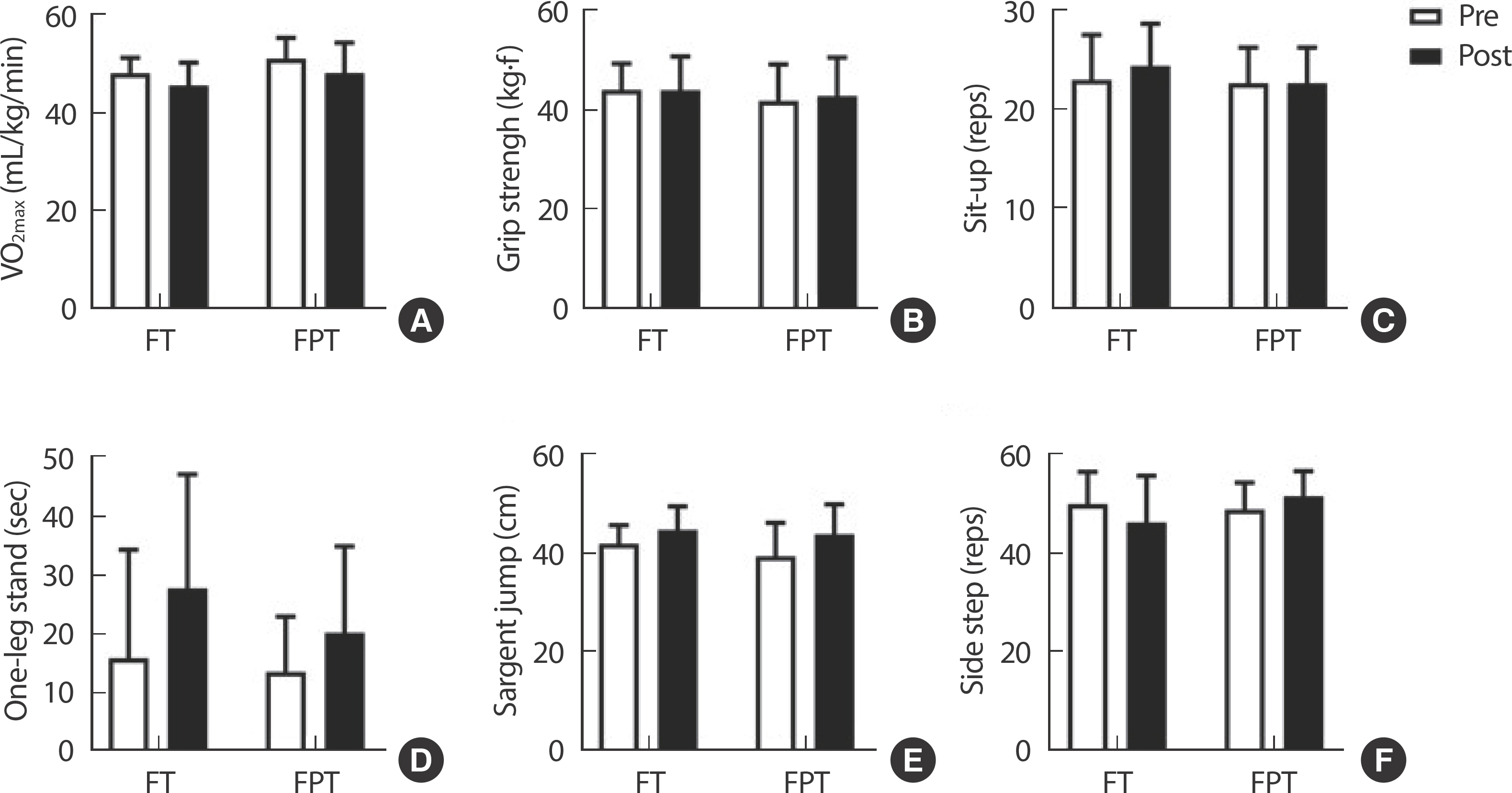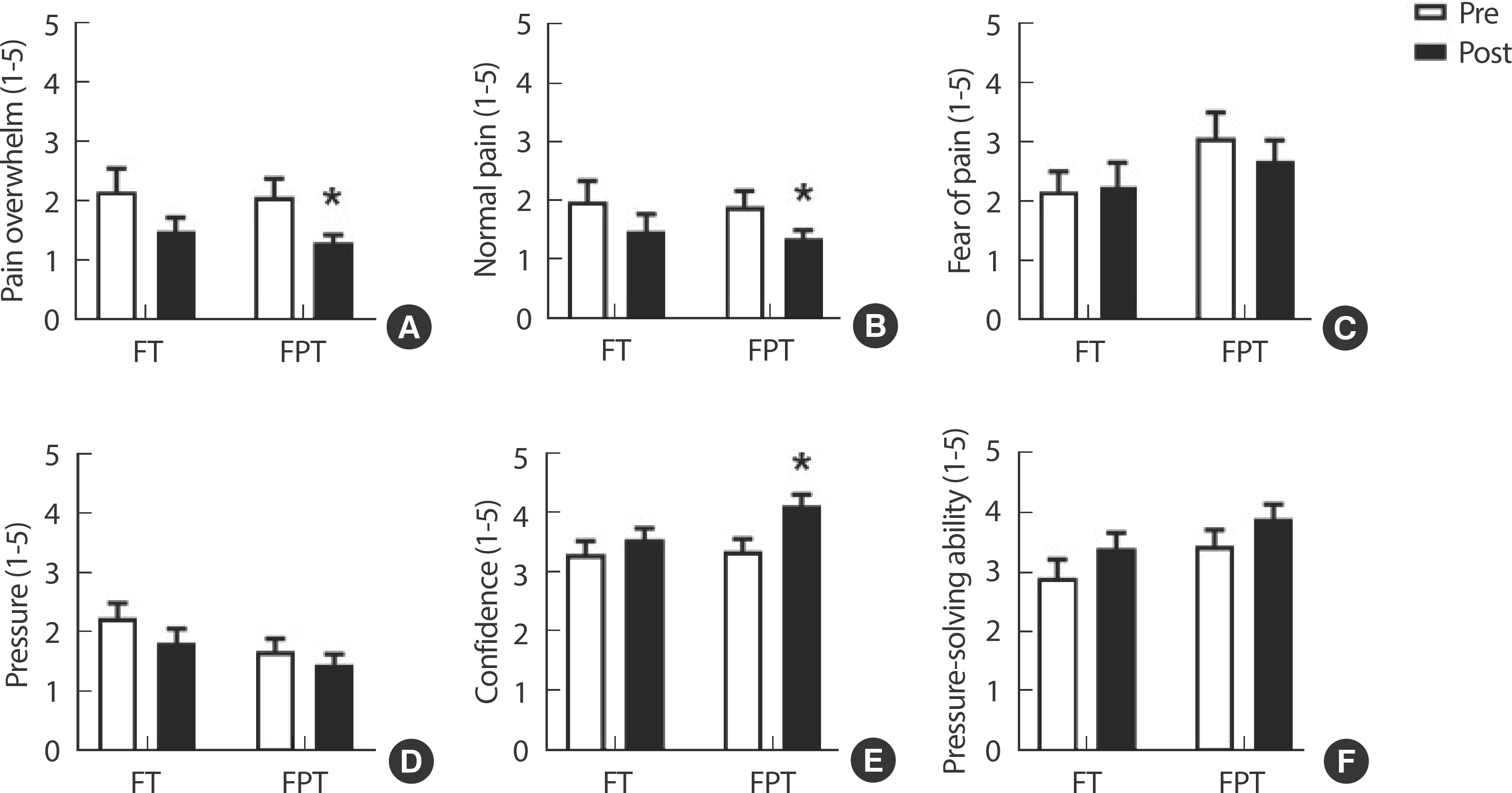Effects of Pilates-Combined Training on the Improvement of Flexibility and Pain Relief in Elite Fencers
Article information
Abstract
PURPOSE
This study aimed to examine the effects of incorporating Pilates into the training regimen of elite fencers, focusing on enhancing flexibility and alleviating pain commonly experienced in the sport.
METHODS
Twenty-five collegiate male elite fencers were stratified into two groups: a fencing training group (FT, n=12, age=18.92±1.08, weight=71.78±7.43 kg, body mass index [BMI]=22.32±2.09 kg/m2) and a fencing-Pilates combined training group (FPT, n=13, age=19.92±0.64, weight=70.97±9.14 kg, BMI=22.61±1.71 kg/m2). Evaluations, including body composition; physical fitness factors; shoulder strength; and joint range of motion in the upper extremities, lower extremities, neck, and spine, were conducted before and after 12 weeks of the intervention. Additionally, examinations of pain catastrophizing and anxiety levels during competitive engagements were performed.
RESULTS
There were no statistical differences in body composition, physical fitness factors, or upper-limb strength between the FT and FPT groups. However, the FPT group exhibited a notable enhancement in shoulder abduction of the upper limb when holding a sword, in contrast to the unchanged metrics observed in the FT group. The positive impact of Pilates-combined treatment on flexibility extended to the neck; waist; and lower extremities, such as hip flexion, hip extension, hip abduction, medial rotation, and ankle dorsi-flexion, coupled with significant improvements in psychological aspects, such as pain relief and related competition anxiety.
CONCLUSIONS
This study confirmed that Pilates-combined treatment can have a beneficial effect on improving flexibility and pain in fencers, and verified the effectiveness of Pilates as an auxiliary training method for elite fencers.
INTRODUCTION
Fencing is a sport that has a long history and is regarded as a prestigious sport in many countries. It originated from the skills and techniques used in combat and has evolved into a modern Olympic sport [1]. Fencing is a competitive sport in one-on-one combat that uses a sword to stab or cut an opponent and requires intensive aerobic energy metabolism and anaerobic lactic acid energy sources during the 3-minute, 3-round match period [1]. Fencing is a highly demanding sport that requires athletes to possess a combination of strength, agility, and flexibility [2]. Fencers rely on quick and precise movements to outmaneuver their opponents, making flexibility a crucial component of their performance [3]. The ability to perform dynamic movements with a wide range of motion is essential in fencing, allowing fencers to lunge, parry, and retreat effectively. Additionally, flexibility plays a role in maintaining proper body alignment and posture, reducing the risk of musculoskeletal injuries. However, the repetitive motions and high-intensity nature of the sport can lead to muscle imbalances and increased risk of injuries, particularly in the lower extremities [4]. Fencers often experience pain, particularly in the lower back and hips, due to the repetitive nature of the sport [5]. These muscle imbalances can stem from the dominance of certain muscle groups over others, leading to compensatory movements and placing undue stress on specific areas of the body [6,7].
Flexibility plays a crucial role in fencing performance as it allows fencers to execute technical movements, maintain proper body alignment, and avoid injuries [8]. In particular, when training through balance improvement, posture control and proprioceptive sensigility can be improved, which can help prevent injury [9]. Dequate flexibility enables fencers to perform lunges, lunges with recovery, and other demanding actions required in the sport. Therefore, optimizing flexibility is important for fencers to excel in their performance and to reduce the risk of injuries [10-13].
In addition to physical demands, elite fencers also face psychological and social pressures. They often have to balance their training schedules with academic or professional commitments, which can be challenging [14]. Moreover, they may struggle with performance anxiety, pressure to achieve competitive success, and the need to constantly improve their skills [15]. Fencers who repeatedly engage in physical training are at risk of physical fatigue, which can lead to injury. Standardized fencing training overlooks the importance of maintaining players’ psychological stability and physical function. Therefore, an auxiliary program is necessary to supplement it. Previous research has shown that incorporating Pilates training can enhance athletes’ function, improve flexibility, and promote mental and physical stability. Therefore, integrating Pilates training into the training regimen of elite fencers could be an effective auxiliary program [16].
Pilates is a well-established exercise method that focuses on core strength, flexibility, and body awareness. Developed by Joseph Pilates in the early 20th century, Pilates exercises aim to strengthen the deep stabilizing muscles of the body while promoting proper alignment and efficient movement patterns. The practice of Pilates has gained popularity in various fields, including sports performance and rehabilitation, due to its ability to improve strength, flexibility, and posture [17,18]. Pilates is a method that enables the body to move freely and perform a variety of exercises, which helps to strengthen specific areas of the body and improve imbalances [19]. Several studies have investigated the effects of Pilates training on athletes from different sports disciplines, such as soccer, basketball, and swimming. These studies have shown promising results in terms of improved flexibility, increased core strength, and reduced risk of injuries [20-22]. Pilates can enhance joint mobility, strengthen re-spiratory muscles, improve cardiopulmonary function [23], and even alleviate metal health conditions such as depression and anxiety [14].
Despite the growing body of evidence supporting the benefits of Pilates in athletes, there is limited research specifically focused on elite fencers [24]. Investigating the effects of Pilates training on flexibility and pain relief can lead to the development of more effective training protocols for elite fencers. It can also provide fencers and their trainers with valuable information to make informed decisions about integrating Pilates into their routines in order to optimize performance and minimize the risk of injury. Therefore, the purpose of this study was to investigate the effects of a Pilates-combined training program on flexibility and pain relief in elite fencers.
METHODS
1. Subjects
Twenty-five Korean collegiate male elite fencers participated in this study. All subjects were registered athletes with the Korean Sport & Olympic Committee, had more than 5 years of experience participating in domestic competitions, and had never performed Pilates. 12 subjects were randomly assigned to the fencing training (FT) group, and the other 13 players were assigned to the fencing-Pilates combined training (FPT) group.
Before and after applying the 12-week exercise intervention, physical factors such as physical fitness and upper and lower extremity flexibility, as well as psychological factors such as pain catastrophizing and state anxiety during competition were evaluated. The physical characteristics of the study subjects are shown in Table 1.
All participants signed a consent form after understanding all information related to the study procedures before participating in the study. This study was conducted with approval from the Institutional Review Board of Gyeongsang National University (IRB No. GIRB-A21-y-0014).
2. Pilates intervention
Both groups underwent the program at the same training time over the same period of 12 weeks. Twelve subjects of the FT group only conducted regular fencing training, and thirteen subjects of the FPT group devoted part of their fencing training time to Pilates exercise (1 hour per day, 3 times a week). To enhance flexibility, low to medium intensity Pilates movements were combined with core-strengthening exercises to help correct asymmetry. Moreover, a large instrument reformer was utilized to alleviate joint stress. The exercise program consisted of 10 minutes of warm-up, 40 minutes of main exercise, and 10 minutes of cool-down, dividing the spine/upper/lower limb movements based on body position. During warm-up and cool-down exercises, upper extremity movements using the reformer, s straps and lower extremity movements using the reformer, s foot bar and straps were performed in the lying position, which allows for the most stable movement. In the main exercise, spine strengthening movements were performed. All Pilates instructors held professional certifications, and the Pilates program was conducted by a team consisting of one instructor with 10 years of professional experience, one instructor with more than 5 years of experience, and one assistant.
3. Muscular strength test
MicroFET2 digital handheld dynamometer (Hoggan Scientific, Salt Lake City, UT, USA) was used to determine changes in shoulder muscle strength. Anterior deltoid muscle strength was measured at the moment the subject raised his arm vertically upward to the front while sitting on a chair with the back straight. Posterior deltoid muscle strength was measured at the moment the subject raised his arm vertically backward. Medial deltoid strength was measured at the moment the subject lifted his arm to the side while sitting on a chair with the back straight. The patient, s arms were straight while measured and the MicroFet2 handheld dynamometer muscle tester was contacted on the patient, s wrist.
4. Physical fitness and flexibility test
Physical fitness factors such as aerobic capacity, muscular strength, muscular endurance, balance, power, and agility were measured by VO2max, grip strength, sit-up, one-leg stand, Sargent jump, and side step, respectively. The maximum oxygen intake was evaluated using the VO2max test. The protocol used Bruce protocol, which applies to healthy athletes in their early 20s. The evaluator gave participants an explanation of the exercise awareness. After wearing oxygen masks. They climbed onto a treadmill that gradually increased in slope and speed, started walking, and ran until they were exhausted. Flexibility was assessed before and after the 12-week training program using two commonly used measures: the sit-and-reach test and the goniometer test. The sit-and-reach test measures hamstring and lower back flexibility, while the goniometer test assesses joint range of motion. Both tests were performed by trained assessors who were blinded to the group allocation of the participants. Goniometer Bending lron 29-5900 (KASCO, Pakistan) was used to measure the range of motion of the upper extremities, spine, and lower extremities. The flexibility of the upper and lower limbs on the dominant side, in relation to the direction in which the sword is held, was measured, taking into account the unidirectional posture characteristics of fencing. To assess the range of motion for each joint, the goniometer, s axis was secured to the central joint after positioning it for measurement. Subsequently, both the fixed arm and exercise arm, s active range of motion were measured. The highest value was re-corded among 3 times of trials.
5. Questionnaires
The questionnaire was a pain catastrophizing questionnaire to check the players’ condition when they are aware of pain, and a total of three questions were measured as ‘ Feeling overwhelmed by severe pain/Feeling like I can’ t bear the pain anymore/Fear of getting more serious’. According to the individual's subjective pain condition, the subject was asked to indicate the answer to the question of ‘1. Not at all/2. Occasional yes/3. Usually yes/4. Often yes/5. Always yes’. In addition, a total of four questions were measured as ‘ Relaxed now/Confident now/Confident to bear mental pressure now/Breathless under pressure now’ as an anxiety questionnaire to check players’ psychological conditions during training and games. Subjects were asked to indicate in the answer of ‘1. Not at all /2. No/3. Normal/4. Yes/5. Very yes’ according to the degree of correspondence with the current competition. Questionnaire assessments were conducted before and after the 12-week training program [25,26].
6. Statistical analysis
Statistical processing for this study was performed using SPSS version 25. Descriptive statistical analysis was used to determine the characteristics of the study subjects. A dependent t-test was conducted to compare pre- and post-measurement values within groups, and an independent t-test was conducted to compare between groups at the same time point. All data used in the study were presented as mean±SD. The statistical significance level was set at p <.05.
RESULTS
1. Effects of the Pilates-combined fencing training on physical fitness
As a result of physical fitness tests, a statistically significant difference was not observed in VO2max, grip strength, sit-up, one-leg stand, Sargent jumps, and side step in between groups at the same time points as well as in between time points of each group (Fig. 1).
2. Effects of the Pilates-combined fencing training on shoulder strength and flexibility
There was no significant difference in shoulder muscular strengths such as anterior, middle, and posterior deltoids in between groups as well as time points. The range of motion at the shoulder abduction was significantly increased by the FPT, while shoulder flexion and extension were not changed significantly (Fig. 2).
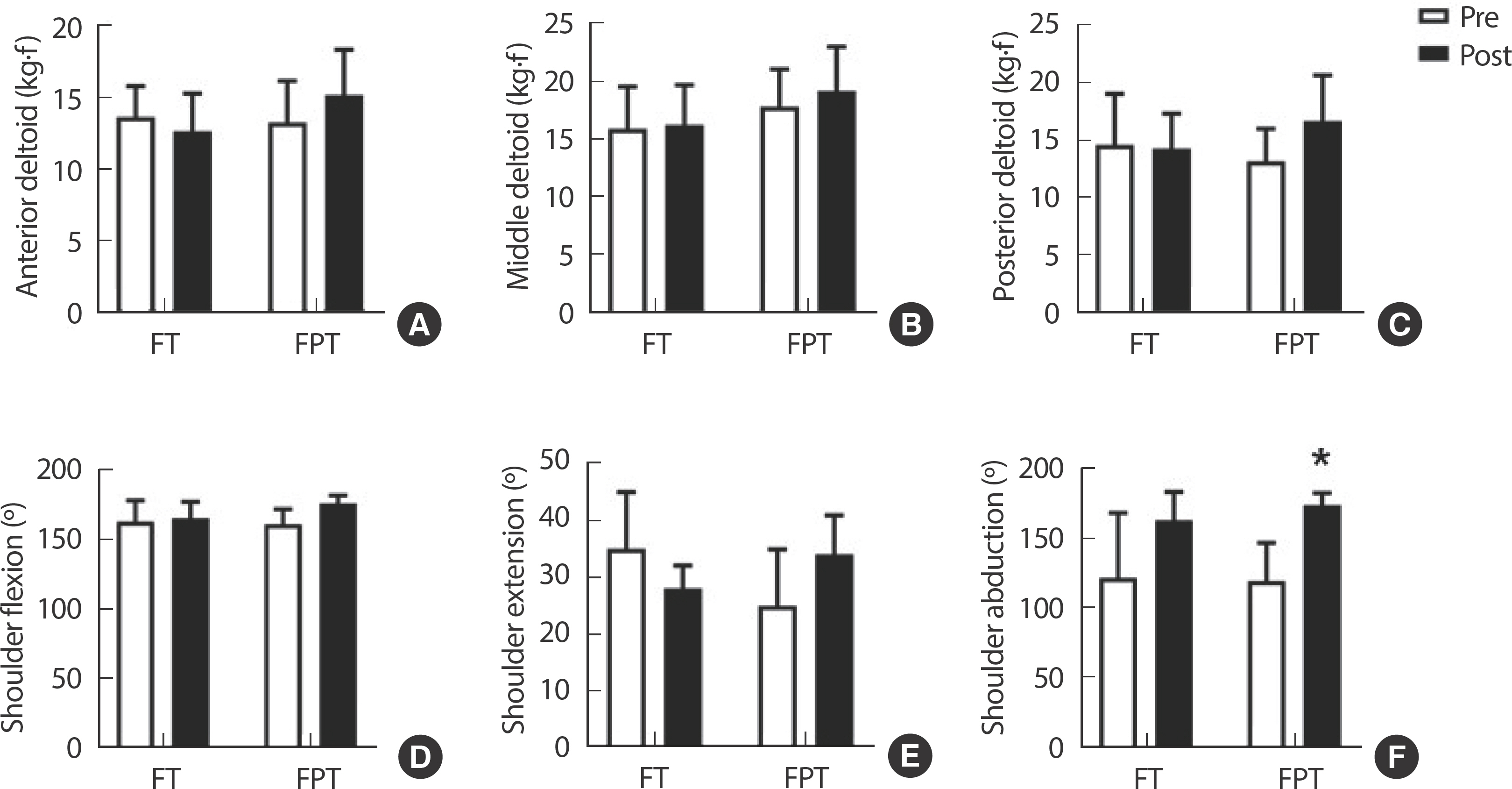
Changes in shoulder muscle strength and flexibility. (A) anterior deltoid strength, (B) medial deltoid strength, (C) posterior deltoid strength, (D) shoulder flexion angle, (E) shoulder extension angle, (F) shoulder abduction angle. All data are presented as mean±standard deviation (SD). * p<.05 compared to pre.
3. Effects of the Pilates-combined fencing training on neck and trunk flexibilities
As a result of neck and trunk flexibility tests using a goniometer, 12 weeks of FPT significantly increased the range of motions in neck lateral flexion, trunk extension, trunk lateral flexion, and trunk rotation, while FT didn’ t have any statistically significant difference for 12 weeks of training (Fig. 3).
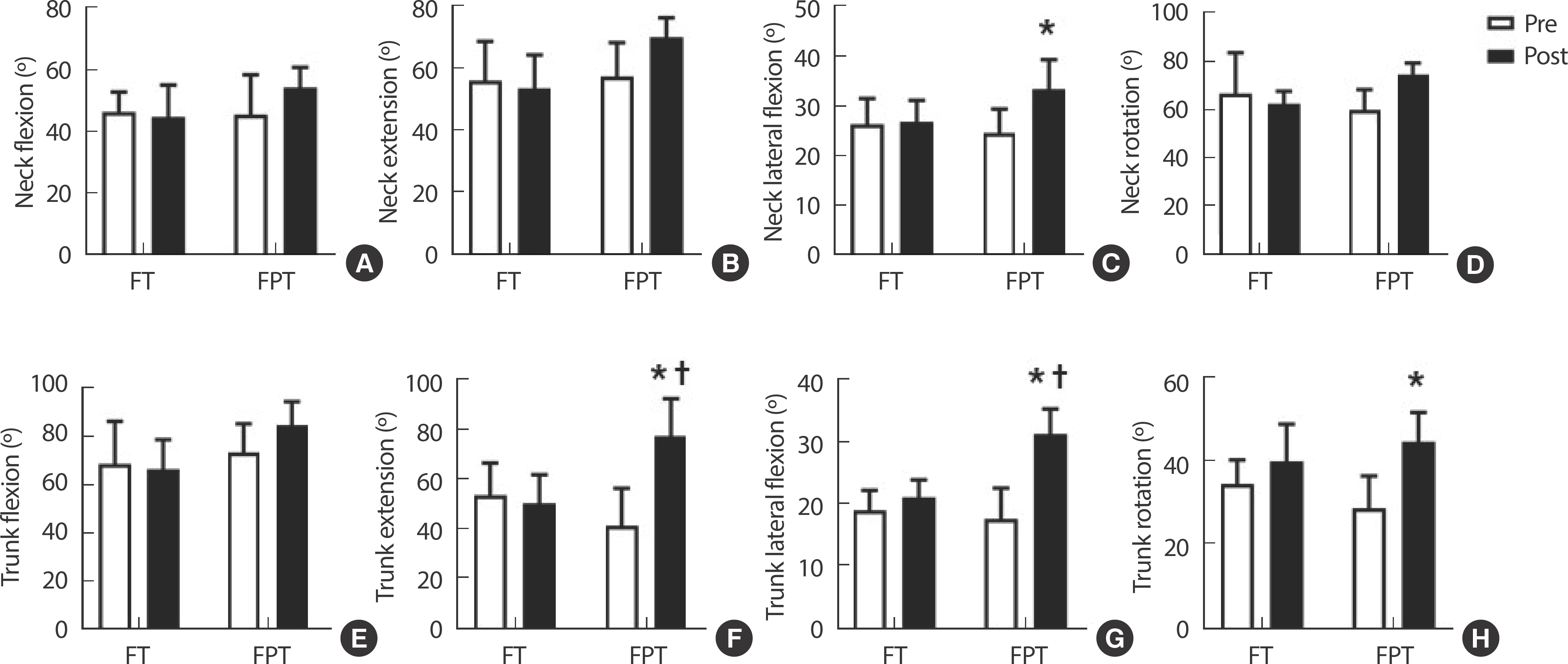
Changes in neck and trunk flexibility. (A) neck flexion, (B) neck extension, (C) neck lateral flexion, (D) neck rotation, (E) trunk flexion, (F) trunk extension, (G) trunk lateral flexion, (H) trunk rotation. All data are presented as mean±standard deviation (SD). * p<.05 compared to pre,† p<.05 compared to FT.
4. Effects of the Pilates-combined fencing training on lower limb flexibility
The 12 weeks of FPT significantly increased the flexibilities of hip flexion, hip extension, hip abduction, hip medial rotation, and ankle dorsi flexion, while fencing training alone didn’ t have significant difference (Fig. 4).
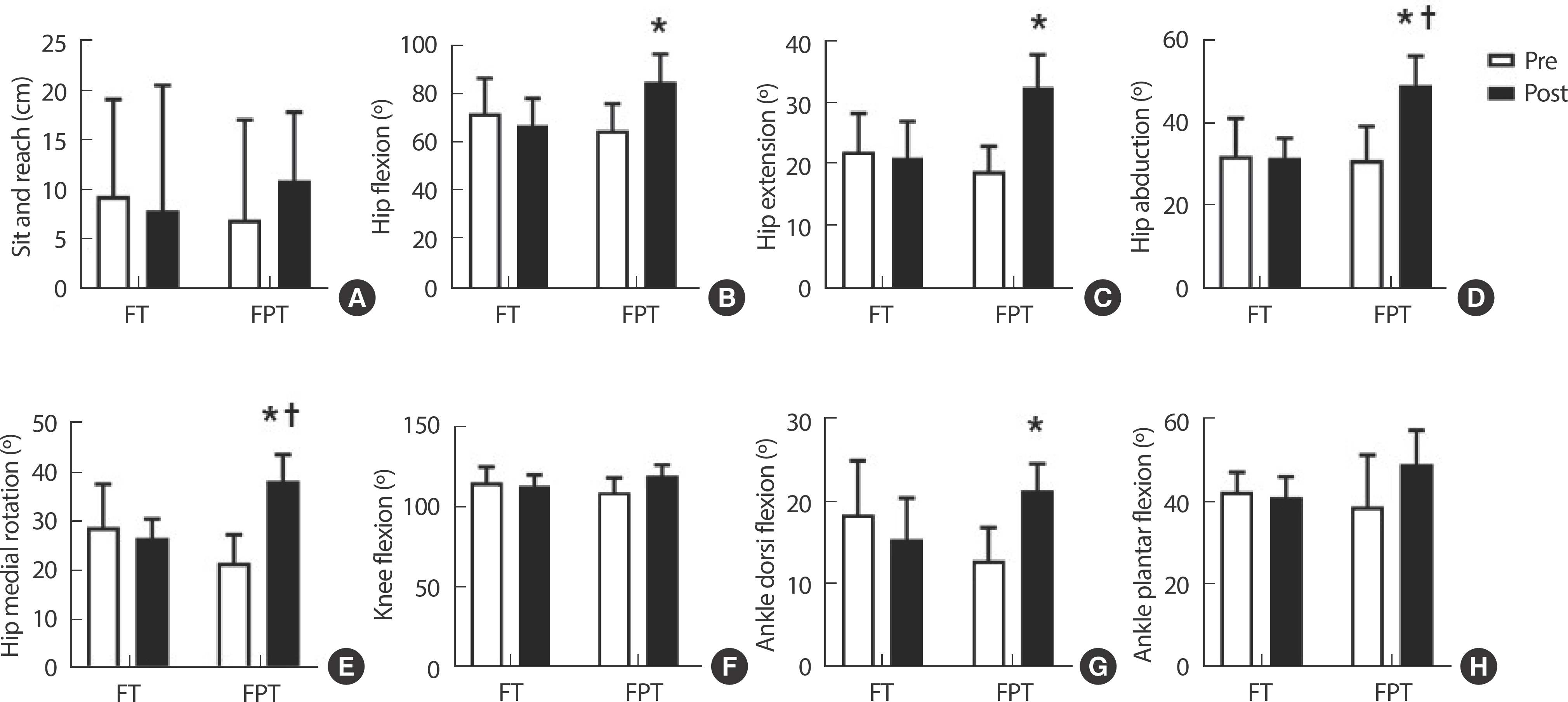
Changes in lower limb flexibility. (A) sit and reach, (B) hip flexion, (C) hip extension, (D) hip abduction, (E) hip medial rotation, (F) knee flexion, (G) ankle dorsi flexion, (H) ankle plantar flexion. All data are presented as mean±standard deviation (SD). * p<.05 compared to pre,† p<.05 compared to FT.
5. Effects of the Pilates-combined fencing training on pain relief and anxiety
Pilates-combined training has shown to decrease the intensity of pain overwhelm and normal pain. Also, the level of confidence to the competition was significantly increased as pain was released in FPT. However, there were no significant changes on levels of pain relief and competition anxiety in FT group (Fig. 5).
DISCUSSION
The results of this study indicate that a Pilates-combined training program can have positive effects on flexibility and pain relief in elite fencers.
First of all, 12 weeks of FT or FPT did not change physical fitness factors in this study. This is interpreted as the fact that the subjects of this study were collegiate elite fencers who had participated in a continuous professional training program for about 10 years or more and their fitness levels were already at the highest, so no significant changes in physical fitness factors were observed over the 12 weeks of training, which was the period of this study (Fig. 1). In addition, these results appear to be possible because both groups continued to combine tactical and physical training before and after the intervention period. Moreover, there was no significant change in the strength of the shoulder of the arm holding the sword in both FT and FPT groups. This result is also interpreted for the same reason (Fig. 2A-C).
According to previous researches, the shoulder flexibility of elite athlete decreases with age or the number of years of competition participation [27]. The decrease in shoulder flexibility can be a factor in various shoulder-joint injuries due to decreased the movement of the scapula. The improvement in upper-limb flexibility, as demonstrated by increased scores on the shoulder abduction test, is essential for fencers to perform dynamic movements with a wide range of motion such as stabbing [28]. In this regard, the increased upper-limb joint range of motion observed in the goniometer test further supports the notion that Pilates training can enhance flexibility and joint mobility in the upper limb, which are critical for optimal performance and injury prevention in the stabbing motion of fencers (Fig. 2D-F).
The nature of fencing, characterized by sustained unidirectional movements while maintaining a fixed sword position and focused gaze, imposes considerable strain on the cervical spine and spinal cord of fencers, predisposing them to potential injuries. Neck stiffness can occur due to a turtle neck in which the forward bending angle of the cervical spine is lost. In order to improve this structural neck deformity, improving the flexibility of various movements of the cervical spine can be helpful [29]. It was confirmed in this study that all spine flexibility, including neck lateral flexion, trunk extension, trunk lateral flexion, and trunk rotation, were significantly improved in the FPT group. As already known from previous studies, this can be seen as a result consistent with the improvement of spinal flexibility, which is known as the main effect of Pilates [30]. In addition, previous studies have demonstrated that implementing a flexibility enhancement yoga program for individuals with spinal discomforts increases spinal flexibility alongside reduced back pain [31]. Concerning those insights, it is postulated that enhancing core flexibility through Pilates training among fencers may correlate with a reduction in spine-related discomfort and potential benefits in enhancing the integrity of the musculoskeletal system [31] (Fig. 3).
In fencing, the capacity of athletes to swiftly change direction both forwards and backwards while maintaining continuous movement is a pivotal determinant of performance. Due to the nature of fencing, which involves unidirectional movement, the main body that suffers asymmet-rical damage in fencers is the lower extremities [32]. In other words, ensuring optimal lower extremity joint function and flexibility is crucial in safeguarding fencers against injuries and performance decline [5]. In this study, FPT significantly increased the lower-limb flexibilities such as hip flexion, hip extension, hip abduction, hip medial rotation, and ankle dorsi flexion, while fencing training alone didn’ t have significant improvement (Fig. 4). Looking at previous studies, it is known that core stabilization exercises and fascial relaxation can have an effect on improving hip joint flexibility [33]. In this study, reformer Pilates, a device that can help improve the flexibility of hip and lower extremity joints by maintaining various postures based on spring control, was applied. Due to the morphological characteristics of the device, the reformer can smoothly use various movements of the lower and upper limb joints by lifting the arms and legs from a lying position, thereby improving each body's flexibility more efficiently. Pilates exercise using large equipment showed the most groundbreaking positive results in improving the flexibility of core joints, including the hip joint in this study.
The reduction in pain intensity reported by the Pilates-combined training group is an important finding, as fencers often experience pain in the lower back and hip regions due to the physical demands of the sport (Fig. 5). The strengthening of the core and supporting muscles through Pilates exercises can help alleviate pain by improving overall body mechanics, reducing muscle imbalances, and enhancing stability. Pain relief is crucial for fencers to perform at their best and avoid injuries that can hinder their training and competitive performance. These results align with previous studies that have investigated the effects of Pilates training on athletes from various sports disciplines [14]. The emphasis on core strength, flexibility, and body awareness in Pilates exercises makes it a suitable training method for enhancing performance and reducing the risk of injuries in athletes [15]. However, this study provides valuable insights specifically into the effects of Pilates training in elite fencers, a population that has received limited attention in previous research.
The findings suggest that incorporating Pilates exercises into the regular training routine of elite fencers can be an effective strategy to improve flexibility and relieve pain. This integrated training approach can help address muscle imbalances, optimize body mechanics, and enhance overall physical performance. It is recommended that fencers and their trainers consider incorporating Pilates into their training programs to achieve these benefits.
While this study provides valuable evidence, there are some limitations to consider. Firstly, the sample size was relatively small, which may limit the generalizability of the findings. Future studies with larger sample sizes would help to further validate the results of this study. Additionally, the study duration was limited to 12 weeks, and the long-term effects of Pilates-combined training in elite fencers remain unknown. Further research is needed to investigate the sustained benefits of Pilates training on flexibility and pain relief in this population.
CONCLUSIONS
In conclusion, the results of this study support the effectiveness of a Pilates-combined training program in improving flexibility and relieving pain in elite fencers. By incorporating Pilates exercises into their regular training routine, fencers can enhance their performance, reduce the risk of injuries, and promote overall physical well-being. Further research is warranted to explore the long-term effects and optimal training protocols of Pilates-combined training in elite fencers.
Notes
The authors declare that they do not have conflict of interest.
AUTHOR CONTRIBUTIONS
Conceptualization: JS Kim; Data curation: HS Lee, KW Baek; Formal analysis: HS Lee, A Lee; Funding acquisition: HS Lee, JS Kim; Methodology: HS Lee, DJ Lee, A Lee; Project administration: JS Kim; Visualization: HS Lee, KW Baek; Writing-original draft: HS Lee, JS Kim; Writing – review & editing: JS Kim, KW Baek, Y Park.


